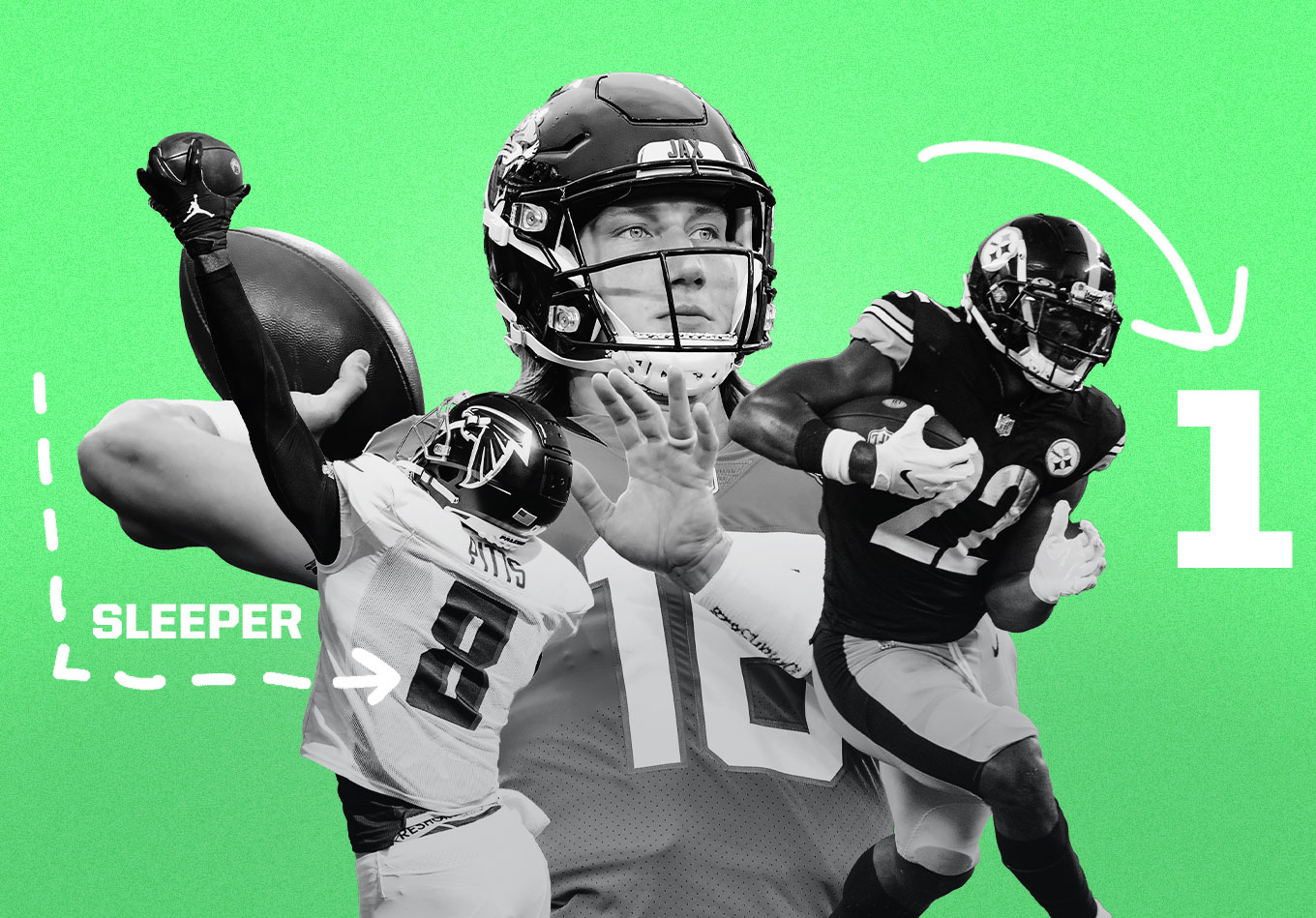At this point, just about everyone has given an opinion on who should be picked come draft day. But who does the data point to as the true impact stars and sleepers who can help fantasy teams this fall? We’ve dug into the metrics to find out.
As we approach prime fantasy football drafting season, let’s dig into one of the biggest unknowns each season: Is there enough information to make an educated guess about how rookies are going to perform, and are they worth our valuable draft picks?
In order to be productive, a player needs one of two things. They either need volume, which is the single most important factor in determining fantasy consistency, or they need to be talented and placed in an advantageous position. One gives you a successful player, a player who can sit comfortably in the QB/RB/WR/TE 2 range.
Both of those factors produce a star, a top-10 player at their position. Run down the list of players being drafted in the first couple of rounds. All are undeniably talented and in a good position as a leading option on their team. All get the lion’s share of touches/targets on their teams.
With that in mind, based on last year alone, drafting a rookie running back can be a promising proposition. Two rookies ranked comfortably inside the top 10 at the running back position and they did it in different ways.
James Robinson, after going undrafted in the 2020 NFL Draft was the massive surprise, winning the Jaguars lead role during training camp and never looking back. Robinson was a beneficiary of volume. For a league-worst team last season, Robinson had the ball a lot – a whopping 289 times to be exact. Alvin Kamara, for example, only got the ball 270 times last season.
Jonathan Taylor came out of a crowded backfield in Indy and ended the season with a streak of six straight excellent games, averaging 140 scrimmage yards and a touchdown. He started the season with less volume, but in an extremely advantageous position, running behind the brilliant Quenton Nelson and an overall strong Colts offensive line. Later in the year, he combined his talent with that additional volume and surged to be a league-winning component for fantasy owners.
Antonio Gibson finished the season in the top 15, capping his season with an evisceration of the Dallas Cowboys on Thanksgiving.
Notably absent from this list though, is the rookie running back who was supposedly the surest thing out of last year’s draft class, Clyde Edwards-Helaire of the Kansas City Chiefs. CEH, the only running back selected in the first round last year, recorded a more-than-respectable 1,100 scrimmage yards but only scored five touchdowns. He wasn’t worth a first- or second-round fantasy pick, which is what was required to draft the LSU star.
Edwards-Helaire ultimately finished in fifth or sixth of all rookie running backs, depending on your league’s scoring format, with both D’Andre Swift and J.K. Dobbins in front of CEH. All six though, were top-25 running backs, making for an extremely productive rookie class at the position.
With our review of the 2020 class in the rearview, let’s attempt to understand what factors and obstacles some of the rookie running backs will face in ascending to the leading role.
Running Backs
Najee Harris, Pittsburgh Steelers
The top rookie being selected in fantasy drafts this year, Harris is in prime position to be the next immediately productive rookie in the world of fantasy football. The top running back selected after a dominant career at Alabama, Harris immediately enters the fray as the undisputed starting running back of the Pittsburgh Steelers. And seeing as Mike Tomlin loves three-down backs like peanut butter loves jelly, that is a good thing.
Since Tomlin took over as head coach in 2007, being the starting running back of the Steelers has been a fantasy delight. During an eight-year stretch when Tomlin felt as though he had a true lead back in Rashard Mendenhall or Le’Veon Bell, the lead back averaged 20 touches a game and 273 carries per season. Now, Harris enters a situation where the Steelers let go of their leading rusher from last season, James Conner, and used a first-round pick on a running back for the first time since…they took Mendenhall in 2008.
Based on the history of Tomlin’s teams, the volume is going to be aplenty. That leaves talent. Well, Harris is entering the NFL after an unstoppable season in Tuscaloosa where he accounted for 1,891 scrimmage yards and 30 touchdowns in 15 games. On his way to producing these historic numbers, Harris forced 78 missed tackles, the most in college football.
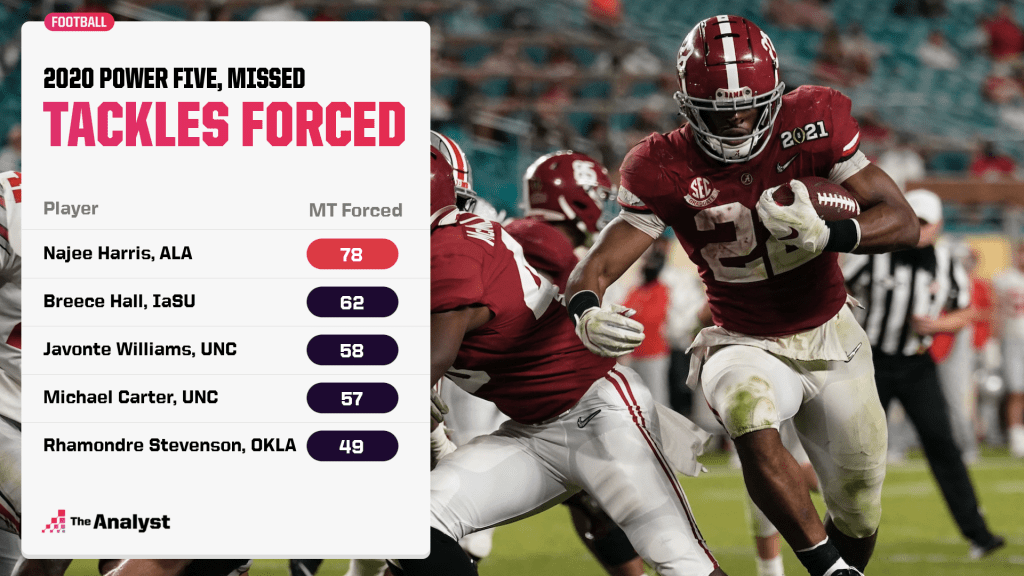
Unlike the other rookies on this list, you aren’t trying to decide whether he’s worthy of a high draft pick. Instead, the decision is should we be drafting him over a player like DeAndre Hopkins. Since that’s the lens in which we’re viewing Harris, it’s reasonable to point out that the Steelers last year were one of the worst rushing teams of the past half-decade. Their 84.4 rushing yards per game is the fifth-worst total by a team since 2017. And while Harris was excellent in forcing missed tackles, he was only average at yards gained after contact with 2.14.
How much Harris can single-handedly improve a porous Steelers rushing attack from a season ago will likely determine whether he ends the season as an RB1. If you believe in him and his talent, the volume will be there. If the chips fall in place for Harris, we are looking at the next superstar running back from Alabama.
Travis Etienne Jr., Jacksonville Jaguars
Think back to above, when we were discussing Robinson’s surprising performance from a season ago. We made the claim that he was the beneficiary of volume. Well, consider the Jags spending a first-round pick on a running back and ask yourself, what do they think about Robinson?
But with Etienne reportedly out for the season after undergoing foot surgery, none of that seems to matter now.
Again, Robinson had a great fantasy year. However, despite being fourth in carries per game, he was only 24th in yards per carry. Similar trends carried over to the passing game, where he tied for sixth with 3.5 receptions per game among running backs but was only 21st in yards per reception. This is where the Jags hoped Etienne might be able to help, but now, Robinson’s fantasy value could skyrocket back into high-end RB2 territory.
Javonte Williams, Denver Broncos
The first of the outstanding duo from UNC, Williams enters a situation in Denver where he’ll be competing with Melvin Gordon III for touches out of the backfield. Gordon has only played a full season once in his career and has only topped 13.5 carries per game twice. That means that while Williams is assured of seeing some touches, the question becomes, can he impress enough to eat into Gordon’s touches and ultimately become the lead back?
If you bet that he can, you’re betting on the declining performance of Gordon, whose career average of 4.1 yards per carry is well below most of the elite running backs. Similarly, his 1.9 yards after contact last season was merely average, sandwiched between names like Jamaal Williams and Brian Hill.
You’re also betting in favor of Williams, who averaged an unbelievable 4.6 yards AFTER contact last season, by far the most in college football amongst players with 100 carries. Perhaps not surprisingly then, Williams was third in college football in missed tackles forced (58) and first in broken tackles (27) by a laughable margin, 12 more than the next best running back.
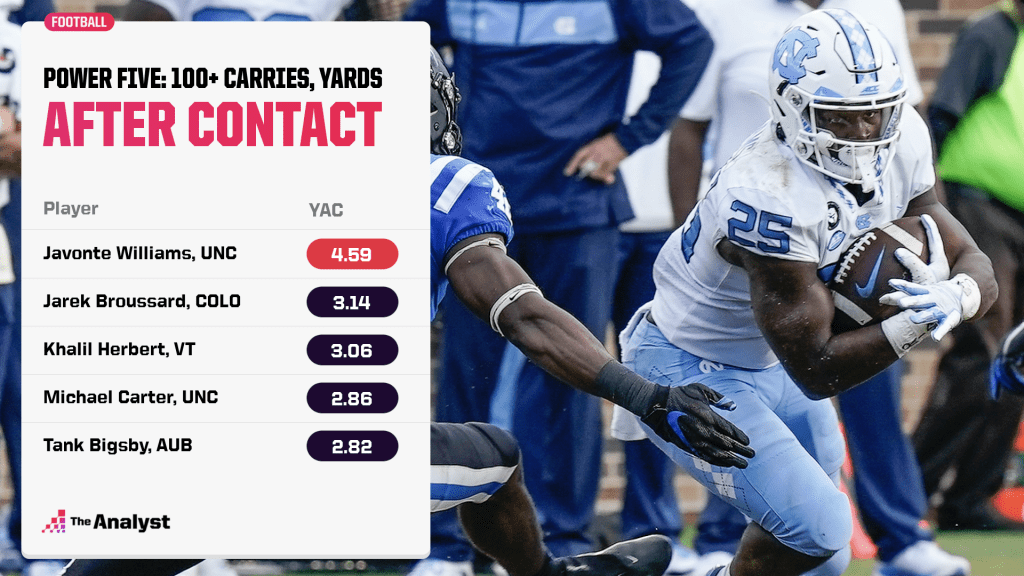
One other area where Williams thrives that he can immediately provide a boost is in the red zone, a valuable set of opportunities in fantasy football. In 27 carries in goal-to-go situations last year, Williams cashed in on 14 of those opportunities. Meanwhile, in Gordon’s last 25 such scenarios running the rock, he has only scored on nine such occasions.
Michael Carter, New York Jets
Unlike Williams, who only must realistically compete with one back for his time, Carter is going to have to overcome a slew of Jets running backs to ascend to the top of the depth chart – Tevin Coleman, La’Mical Perine, and Ty Johnson will all battle for carries.
Coleman is coming off an injury-filled season in which he averaged less than two yards per carry, Perine was below average in yards per carry, yards before contact and yards after contact, and Johnson was waived last season by Detroit before being picked up by the Jets.
The other half of the Tar Heels’ backfield may have even put up more impressive numbers at Chapel Hill. His 8.0 yards per carry was first amongst running backs with 100 carries on the season. That massive number was achieved on the back of an excellent 5.4 yards per rush before contact average, highlighting his exceptional ability to burst through the line.
Carter averaged a nearly identical number rushing on first downs, with 7.9 yards per carry. Playing for new Jets offensive coordinator Mike LaFleur should be a boost. Back with the 49ers in 2019, with a healthy QB leading the way, LaFleur helped spearhead an offense that was second in first down rushing average. Even without health, the Niners were still in the top eight in first down rushing this past season.
If Carter can come out of the crowded backfield and assume lead back responsibilities, his style of running should mesh very well with LaFleur’s offensive attack.
Trey Sermon, San Francisco 49ers
If you’re drafting Trey Sermon, there are likely two main reasons: that stunning performance vs. Northwestern in the Big Ten Championship game, and Kyle Shanahan. The former was the most impressive individual performance all season, as Sermon set an Ohio State record with a 331-yard onslaught of Northwestern.
The game was indicative of Sermon’s entire season, he finished stronger than he started. He had 60 yards in the first half, before exploding for 271 yards after halftime. Sermon, in the second half of games, averaged nearly 2.5 more yards per carry than in the first half. His 7.5 average per carry overall was third best in the Power Five, and his 4.9 yards before contact was fourth in college football of running backs with 100 carries.
Shanahan’s 49ers have had the opposite effect in games. Again using 2019 because of injuries last year, the 49ers were second in overall rushing attempts in the second half, but only 27th in average per carry. Current starter Raheem Mostert got worse as the game went on, going from a 7.4 average in the first half to a 4.9 average in the second half (regular and postseason).
Pass-Catchers
While we look at rushing attempts when we analyze volume in the backfield, for pass-catchers, we care as much about targets as we do receptions.
Similar to running backs, talent still dictates who will be receiving these targets, but extraneous circumstances matter more here than they do for running backs. Having Patrick Mahomes throw you the ball is a little more valuable than having Tyrod Taylor as your quarterback, for example.
Kyle Pitts, Atlanta Falcons
The first non-QB selected in this year’s draft, Pitts comes out of college with arguably the most hype of any tight end ever selected. Pitts averaged a shade under 18.0 yards per reception as the No. 1 option for a lethal Florida Gators offense.
With a burn percentage of 48.8% – easily pacing all tight ends with at least 50 targets – and 849 burn yards which also led all tight ends, Pitts enjoyed a massive season. He capped it off with a sensational performance against Alabama in the SEC Championship game, catching seven of 12 targets for 129 yards and a touchdown. His 12 touchdowns paced the position, and despite the large workload, he never dropped a single pass, the only tight end in college football with at least 50 targets to do so.
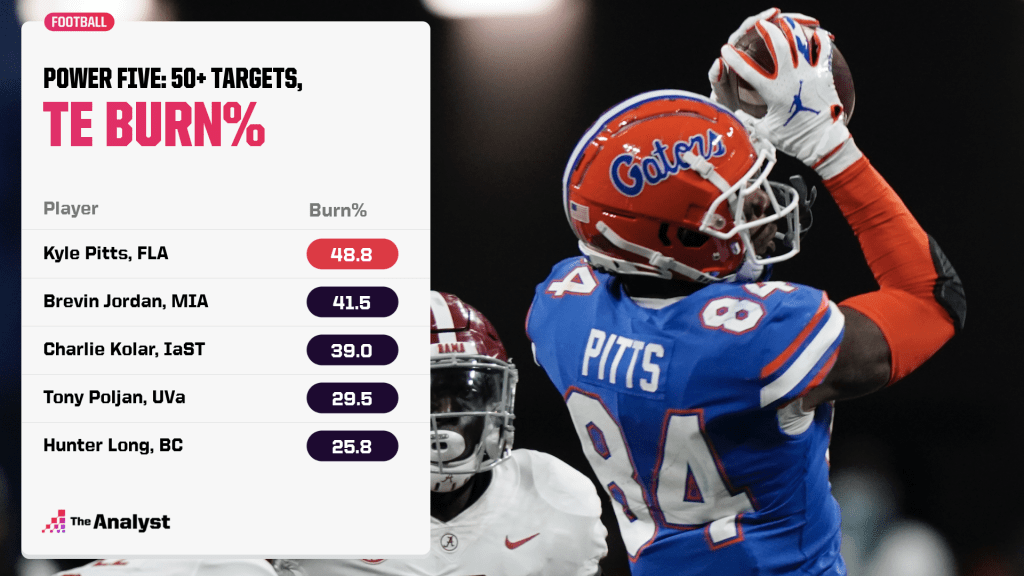
The great news for Pitts fans is that he enters the NFL in favorable circumstances. With Calvin Ridley firmly entrenched as the top pass-catcher, Pitts won’t have to deal with being the top option right away. However, Atlanta does need to replace all the targets that were previously directed towards Julio Jones and Pitts feels like a very good candidate to take that over.
On top of that, Pitts will have a veteran quarterback throwing to him, one who’s not afraid to unleash the ball downfield. Matt Ryan’s air yards of 9.0 were seventh among quarterbacks with 150 passing attempts. For those worried about Hayden Hurst, new head coach Arthur Smith comes over from Tennessee and brings a system that is used to incorporating, and more importantly targeting, two tight ends. To that end, the Titans targeted their tight ends sixth most in the NFL last season, so there should be plenty of opportunities for Pitts to impress.
Ja’Marr Chase, Cincinnati Bengals
The most dominant receiver in 2019, the LSU alum didn’t take the field this past year. He reunites with his Heisman Trophy-winning QB, Joe Burrow, as they look to help end a five-year playoff drought for the Bengals.
Justin Jefferson was a key part of that 2019 LSU offense, and he is coming off a special rookie season in which he set the record for receiving yards with a clean 1,400 yards. But if you recall, Chase was the top receiver for that Tigers team. Averaging a monstrous 21.2 yards per catch, that trailed only CeeDee Lamb among receivers with 40 receptions, Chase capped his season with a nine-catch, 221-yard performance in the National Championship game.
Chase excelled even though he was below average in getting open (61.8% of targets), largely because of his prowess in making contested catches. The difficulty for Chase will be the rather crowded receiver situation in Cincinnati, where incumbent receivers Tee Higgins (top 25 in burns) and Tyler Boyd (eighth out of receivers with 100 targets in open percentage) have both already been productive NFL receivers.
With that said, the emergence of Jefferson in Minnesota and the thought that the Bengals will be throwing the ball a lot this season, Chase is an intriguing receiver, one with the potential to put up numbers rivaling Jefferson if all breaks his way.
DeVonta Smith, Philadelphia Eagles
The Heisman Trophy winner from last season was the most dominant player in every game he played. That includes the aforementioned SEC Championship game, where he had 15 catches for 184 yards and two touchdowns as he and ’Bama topped Pitts and Florida in a wild shootout.
He led college football in so many categories, we’re just going to list a few of our favorites, and the margin he led by:
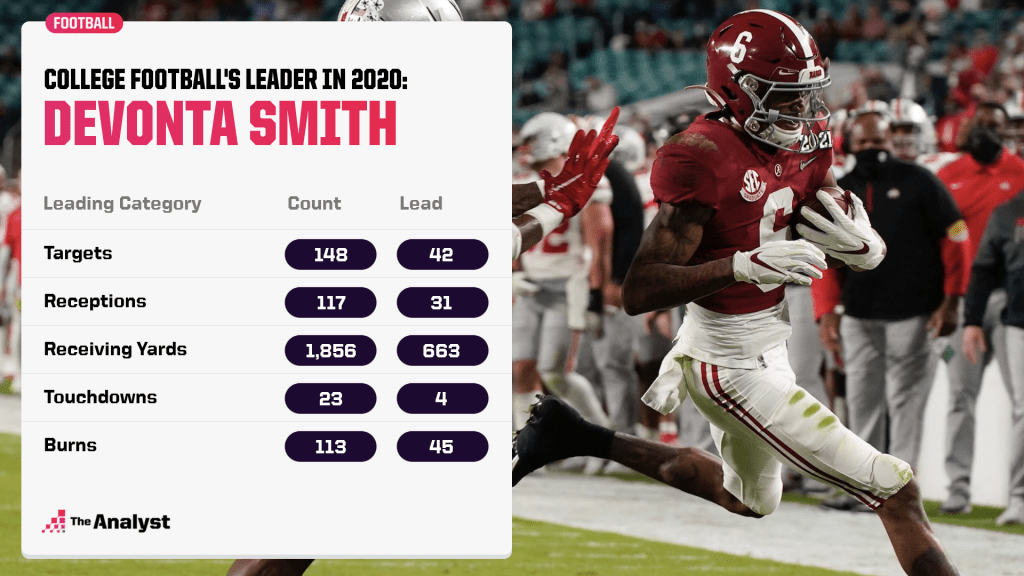
Based on talent and potential opportunity, Smith is in line for a potentially monster rookie season. Eagles receivers struggled to perform and stay healthy last year as Travis Fulgham led his squad with 539 yards. Smith should step in immediately in the top spot and receive a fair share of targets. And he too will have tons of familiarity with his quarterback, as Smith and Eagles starter Jalen Hurts were teammates at Alabama.
Quick Hitters on QBs:
Trevor Lawrence, Jacksonville Jaguars
Likely the only quarterback worth potentially starting Week 1, Lawrence is being given the keys to an offense that underperformed last year but has talent permeating throughout the lineup. Lawrence led all quarterbacks in well-thrown percentage (84.3) in 2020, and his crop of wide receivers could help catapult Lawrence into top-10 contention.
Zach Wilson, New York Jets
Wilson’s best attribute is his deep ball. Out of all quarterbacks with 200 passing attempts, Wilson finished eighth in air yards. With only three interceptions to go with all that aggressiveness, look for Wilson to target Denzel Mims, whose depth of target (16.4) was seventh of all NFL players with 20 targets on the season.
Trey Lance, San Francisco 49ers
Lance is the highest risk-reward draftable rookie quarterback. Armed with an absolute cannon – his 80-yard TD in the first preseason game is already longer than Jimmy Garoppolo’s longest play with the 49ers – and running legs that could prove deadly in Shanahan’s offense, Lance could be important come fantasy playoffs.
That remains a big if though, because unlike the other teams integrating rookie quarterbacks, the 49ers are operating with the sense of urgency that usually surrounds a contending team, and as is well known, no rookie quarterback has ever led their team to the Super Bowl. Meaning that this is the situation that is most likely to see the rookie quarterback sit behind the incumbent.
Justin Fields, Chicago Bears
Out of every quarterback who had a well-thrown% above 80%, Fields was one of only three to also have 10 air yards per pass attempt. This combination of arm strength and accuracy should make him relevant in fantasy the second he starts playing. With Allen Robinson to throw to, Fields may become a top-10 quarterback as soon as Matt Nagy announces him the starter.
Design by Matt Sisneros.
